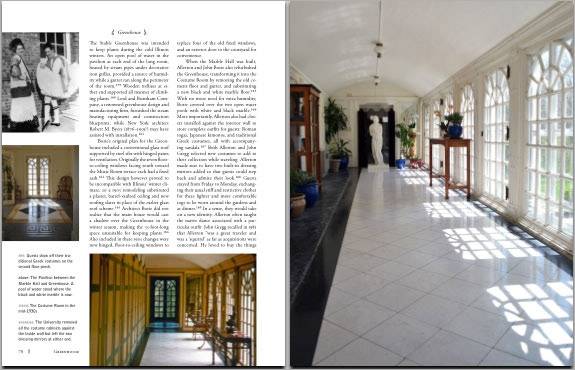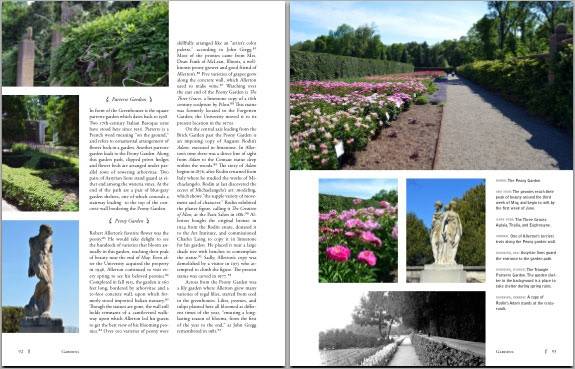Like many townies, I spent countless hours exploring Robert Allerton Park as a child. Also like many townies, I largely took Allerton for granted and never thought to question why there was a 1500 acre park with a giant mansion, gorgeously planned gardens, and, perhaps most notably, a giant naked statue of Apollo (the well-known “Sun Singer”) just a short drive away from Champaign-Urbana.
As I got older I did pick up on some snippets of the story—Allerton was the beloved project of a very wealthy man named Robert Allerton, who eventually gifted the house and land to the University of Illinois—but I was still excited to pick up David L. Finnigan’s new book, Inside Allerton: The Essential Guide to Allerton Park, to learn more about the story behind this local attraction. The book is an 128 page history of the construction of Allerton with a few anecdotes included about the people involved: not just Robert Allerton but also his companion John Gregg and the many servants who kept the mansion running.
 Finnigan is a graduate student in architecture at SIU, and his specialty is definitely apparent as you read through the book. Much of the text is given over to room-by-room or garden-by-garden descriptions of how particular design features or materials were chosen for each space. Fortunately, the book includes a number of photographs on each page to jog the memory of those who may not have visited the mansion or park recently. After a certain point, though, I did find myself wishing I was actually out at Allerton so I could see for myself what Finnigan was talking about, especially as there were some details described that I wasn’t able to find in the accompanying photos. For a reader curled up on a couch far away from Allerton, especially one unfamiliar with the finer points of architectural design, the extremely detailed descriptions of the house eventually began to blur together.
Finnigan is a graduate student in architecture at SIU, and his specialty is definitely apparent as you read through the book. Much of the text is given over to room-by-room or garden-by-garden descriptions of how particular design features or materials were chosen for each space. Fortunately, the book includes a number of photographs on each page to jog the memory of those who may not have visited the mansion or park recently. After a certain point, though, I did find myself wishing I was actually out at Allerton so I could see for myself what Finnigan was talking about, especially as there were some details described that I wasn’t able to find in the accompanying photos. For a reader curled up on a couch far away from Allerton, especially one unfamiliar with the finer points of architectural design, the extremely detailed descriptions of the house eventually began to blur together.

I’ve personally spent much more time in the gardens than in the mansion at Allerton (I’m actually not sure I’ve ever been inside the mansion!), so I was more eager to learn about areas like the Sunken Garden, the “goldfish pond”, and the Sun Singer statue that are more familiar to me. The sections about the gardens brought back countless childhood memories of chasing friends through the Chinese Maze, picnicking beneath the Centaur statue, and making the trek to visit the Fu Dogs (or “Blue Dogs”, as Robert Allerton called them) in their garden. I bring up these personal connections because I think they made a big difference in how well I was able to connect with the text. It was neat to contrast my experiences of the park with how it would have been in Allerton’s day and to learn more about the origins of the gardens I’ve been enjoying for so much of my life.

The Sun Singer statue, for example, is a copy of a statue in Sweden. Allerton thought he was commissioning a smaller copy for himself but discovered when it arrived that something had been lost in translation and that he now had a 15-foot statue to place in his gardens. I regret to report that, according to this book, he then took the somewhat shifty path of buying adjacent land under false pretenses and then clearing existing houses away to make room for the grand setting the statue now enjoys in “Sun Singer Meadow.” I love to imagine some of the conversations that must have taken place in Monticello around this time about Mr. Allerton and his colossal statue!
As a history buff, it was the stories like these that I most enjoyed about this book. While the architecture and design of Allerton are the primary focus, Finnigan has found plenty of interesting anecdotes about the life of the estate that keep things from becoming unbearably dry for readers who aren’t as into architecture as he is. I enjoyed reading about the sailboat races local children held and about the head gardeners who kept everything up to Allerton’s standards (though apparently they were expected to disappear over weekends when guests were present).
I was a little surprised, however, that the book glosses over the importance of John Gregg, Allerton’s companion of over thirty years. Finnigan briefly describes the men’s first meeting but then lets that part of Allerton’s story trail off at Gregg being declared Allerton’s chief architect, leaving readers to extrapolate for themselves why Gregg would then have his own room at the mansion and would eventually move to Hawaii with Robert Allerton. I was surprised that there wasn’t at least one sentence stating more explicitly how important Gregg was to Allerton. (There were two places in my Advance Review Copy where the text seemed to cut off abruptly, but I don’t think any of the potentially missing text would have logically covered this part of Allerton’s life.)
 Overall, however, I found Inside Allerton to be an enjoyable read, and my feeling is that anyone who’s spent a notable amount of time at the park would probably also enjoy at least leafing through it. The combination of photographs, narrative, and extensive notes make this a great resource for local history buffs, even if the somewhat dry tone of some of the content makes it a little tough to read straight through from cover to cover. Regardless, I now have a much greater appreciation of the planning and work that went into creating Allerton Park, and Inside Allerton made me want to make another trip out to Monticello soon to forge even more memories of this local treasure.
Overall, however, I found Inside Allerton to be an enjoyable read, and my feeling is that anyone who’s spent a notable amount of time at the park would probably also enjoy at least leafing through it. The combination of photographs, narrative, and extensive notes make this a great resource for local history buffs, even if the somewhat dry tone of some of the content makes it a little tough to read straight through from cover to cover. Regardless, I now have a much greater appreciation of the planning and work that went into creating Allerton Park, and Inside Allerton made me want to make another trip out to Monticello soon to forge even more memories of this local treasure.
Inside Allerton: The Essential Guide to Robert Allerton Park by David L. Finnigan. ISBN: 978-0-692-86740-2. G.S. Brenac, 2017. US Price: $34.99. 128 pp. The book is available through to order through the publisher’s website.








